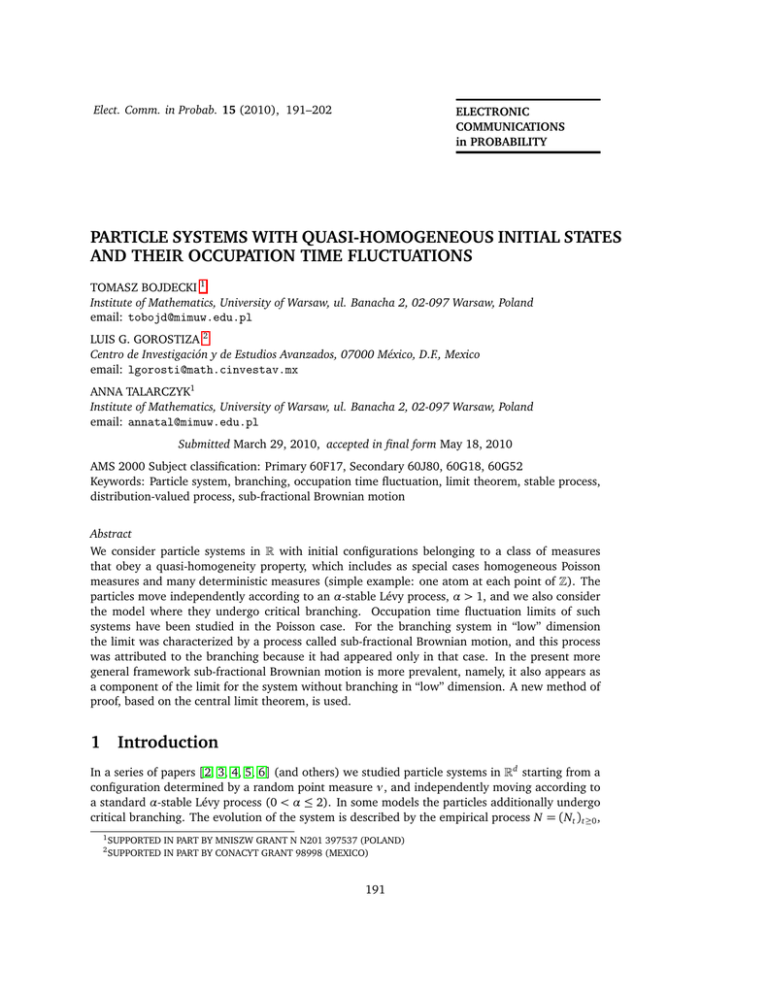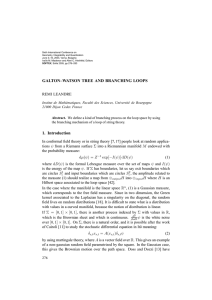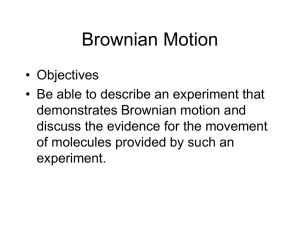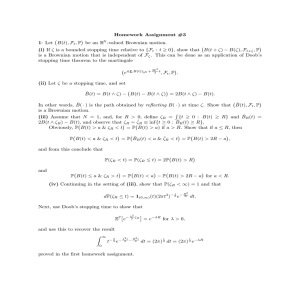PARTICLE SYSTEMS WITH QUASI-HOMOGENEOUS INITIAL STATES AND THEIR OCCUPATION TIME FLUCTUATIONS
advertisement

Elect. Comm. in Probab. 15 (2010), 191–202
ELECTRONIC
COMMUNICATIONS
in PROBABILITY
PARTICLE SYSTEMS WITH QUASI-HOMOGENEOUS INITIAL STATES
AND THEIR OCCUPATION TIME FLUCTUATIONS
TOMASZ BOJDECKI 1
Institute of Mathematics, University of Warsaw, ul. Banacha 2, 02-097 Warsaw, Poland
email: tobojd@mimuw.edu.pl
LUIS G. GOROSTIZA 2
Centro de Investigación y de Estudios Avanzados, 07000 México, D.F., Mexico
email: lgorosti@math.cinvestav.mx
ANNA TALARCZYK1
Institute of Mathematics, University of Warsaw, ul. Banacha 2, 02-097 Warsaw, Poland
email: annatal@mimuw.edu.pl
Submitted March 29, 2010, accepted in final form May 18, 2010
AMS 2000 Subject classification: Primary 60F17, Secondary 60J80, 60G18, 60G52
Keywords: Particle system, branching, occupation time fluctuation, limit theorem, stable process,
distribution-valued process, sub-fractional Brownian motion
Abstract
We consider particle systems in R with initial configurations belonging to a class of measures
that obey a quasi-homogeneity property, which includes as special cases homogeneous Poisson
measures and many deterministic measures (simple example: one atom at each point of Z). The
particles move independently according to an α-stable Lévy process, α > 1, and we also consider
the model where they undergo critical branching. Occupation time fluctuation limits of such
systems have been studied in the Poisson case. For the branching system in “low” dimension
the limit was characterized by a process called sub-fractional Brownian motion, and this process
was attributed to the branching because it had appeared only in that case. In the present more
general framework sub-fractional Brownian motion is more prevalent, namely, it also appears as
a component of the limit for the system without branching in “low” dimension. A new method of
proof, based on the central limit theorem, is used.
1
Introduction
In a series of papers [2, 3, 4, 5, 6] (and others) we studied particle systems in Rd starting from a
configuration determined by a random point measure ν, and independently moving according to
a standard α-stable Lévy process (0 < α ≤ 2). In some models the particles additionally undergo
critical branching. The evolution of the system is described by the empirical process N = (Nt ) t≥0 ,
1
2
SUPPORTED IN PART BY MNISZW GRANT N N201 397537 (POLAND)
SUPPORTED IN PART BY CONACYT GRANT 98998 (MEXICO)
191
192
Electronic Communications in Probability
where Nt (A) is the number of particles in the set A ⊂ Rd at time t. The object of interest is the
limit of the time-rescaled and normalized occupation time fluctuation process X T defined by
X T (t) =
1
FT
Z
Tt
(Ns − ENs )ds,
t ≥ 0,
(1.1)
0
as T → ∞, where F T is a suitable deterministic norming. The process X T is signed measurevalued, but we regard it as a process with values in the space of tempered distributions S 0 (Rd )
for technical reasons, and also because in some cases the limit is genuinely S 0 (Rd )-valued. In
all the cases considered in the abovementioned papers the initial measure ν was a Poisson field,
homogeneous or not. This assumption permitted to investigate convergences conveniently with
the help of the Laplace transform (due to infinite divisibility). The results always exhibited the
same type of phase transition: for “low” dimensions d the limit process was the Lebesgue measure
multiplied by a real long-range dependent process, whereas for “high” dimensions the limit was
an S 0 (Rd )-valued process with independent increments. A natural question is what happens for
non-Poisson initial measures ν. Miłoś [10, 11] considered (critical) branching systems where ν
was an equilibrium measure. In that model the limits have a similar dimension phase transition.
In the present paper we investigate what happens with initial measures of other types, for example, some measures that are deterministic or almost deterministic. For simplicity we consider
d = 1 and assume that the motions are either without branching or with the simplest critical binary branching. We define a class M of measures ν which contains in particular homogeneous
Poisson measures (which are “completely random”), and quasi-homogeneous deterministic measures (e.g., one atom at each point of Z, which is “completely deterministic”), and we develop a
unified approach that permits to obtain limits of X T for any initial measure ν ∈ M . By a quasihomogeneous deterministic point measure on R we mean any measure defined by the following
procedure: Given a positive integer k, in each interval [ j, j + 1), j ∈ Z, we fix k points. For a
general ν ∈ M , each interval [ j, j + 1) contains θ j points chosen at random, and θ j , j ∈ Z, are
i.i.d. random variables. The main feature of those measures is this form of quasi-homogeneity and
independence on the family of intervals [ j, j +1). The idea of the proofs in this general framework
is simpler than that in our previous papers, and is based on the central limit theorem.
Some of the results we obtain are unexpected. It turns out that the only case where new limits
appear is the non-branching case with (d = )1 < α. They have the form Kλξ, where K is a
constant, λ is the Lebesgue measure, and ξ is the sum of two independent processes, one of them
is a sub-fractional Brownian motion (see (2.3)), and the other one is a new (centered continuous
long-range dependent) Gaussian process (see (2.4) and Remark 2.3(c)). The process ξ depends on
the initial measure ν only through Eθ0 and Var θ0 . In particular, for a deterministic ν this process
reduces to a sub-fractional Brownian motion, and in the homogeneous Poisson case, as well as
for any ν with Eθ0 = Var θ0 , it yields a fractional Brownian motion (see Remark 2.3(a)(b) for
more comments). This result seems surprising since in all earlier papers sub-fractional Brownian
motion was related only to branching systems, and was consequently attributed to the branching,
but in the present framework this process is more “natural” than fractional Brownian motion. On
the other hand, fractional Brownian motion, which is typically related to systems in equilibrium
(in particular the non-branching system with initial homogeneous Poisson measure), now appears
also for a wider class of quasi-homogeneous initial measures. In all the remaining cases the limits
are (up to constants) the same, and with the same normings F T , as those for homogeneous Poisson
models [3, 4].
The results show that within the class M the fluctuations caused by the branching are so large
that X T “forgets” the randomness of the initial state of the system (it “remembers” Eθ0 only). On
Particle systems with quasi-homogeneous initial states and their occupation time fluctuations
the other hand, for low dimensions it does distinguish between ν ∈ M and the equilibrium initial
state [10] (which is not in M because the branching introduces spatial dependence). Another
conclusion is that for high dimensions (which for d = 1 amounts to small α), the fluctuation
process “forgets” the initial measure, as long as it is in some sense homogeneous (i.e., ν ∈ M ),
and this property holds for both the branching and non-branching systems, and also for branching
systems in equilibrium.
In this paper we are interested mainly in identifying the limit processes, therefore we do not
prove convergence in functional form, but only for finite-dimensional distributions. Presumably,
convergence also holds in C([0, τ], S 0 (R)) for any τ > 0.
We have not found results in the literature concerning occupation times for particle systems starting from a deterministic or quasi-deterministic point measure. Some kinds of quasi-homogeneity
of initial configurations for systems of independent particles, different from those in this paper,
appear in other contexts in [14] and [8] (see Remark 2.5 (h)).
The following notation is used in the paper.
λ: Lebesgue measure.
S (R): space of C ∞ rapidly decreasing function on R.
S 0 (R): space of tempered distributions (topological dual of S (R)).
⟨ , ⟩: duality on S 0 (R) × S (R).
⇒ f : weak convergence of finite-dimensional distributions of S 0 (R)-valued processes.
p t (x): transition probability density of the standard symmetric α-stable Lévy process in R.
T t : semigroup determined by p t , i.e., T t ϕ = p t ∗ ϕ.
G: potential operator determined by p t for α < 1, i.e.,
Gϕ(x) =
Z
∞
0
T t ϕ(x)d t = Cα
Z
R
ϕ( y)
|x − y|
d y, Cα =
1−α
Γ( 1−α
)
2
2α π1/2 Γ( α2 )
.
Generic constants are written C, Ci , with possible dependencies in parenthesis.
In Section 2 we describe the particle system, formulate the results and discuss them. Section 3
contains the proof of Theorem 2.2(a), which is the only case where a new type of limit appears.
The other proofs are in general more elaborate (although the new method is simpler than the one
used before), specially for the branching system due to the non-linearity caused by the branching,
and they can be found in [7]. That paper, which is a full-length version of the present one, contains
more references and an example where convergence in C([0, τ], S 0 (R)) is proved (Proposition
2.6).
2
Results
We start with detailed description of the particle system.
Let θ be a non-negative integer-valued random variable with distribution
P(θ = k) = pk , k = 0, 1, 2, . . . ,
(2.1)
such that Eθ 3 < ∞. This moment condition is a technical assumption satisfied by all cases of
interest in this paper, but we suppose that finiteness of the second moment could be sufficient.
j
Let θ j , j ∈ Z, be independent copies of θ , and for each j ∈ Z and k = 1, 2, . . ., let ρk =
j
j
j
(ρk,1 , . . . , ρk,k ) be a random vector with values in [ j, j + 1)k . We assume that (θ j , (ρk )k=1,2 , . . .),
j ∈ Z, are independent. These objects determine a random point measure ν on R in the following
193
194
Electronic Communications in Probability
way: For each j, θ j is the number of points in the interval [ j, j + 1), and for each k, if θ j = k, the
j
positions of those points are determined by ρk . In other words,
ν=
θj
XX
δκ j,n ,
(2.2)
j∈Z n=1
j
where κ j,n = ρθ ,n and δa is the Dirac measure at a ∈ R. We denote by M the class of all such
j
measures ν.
j
Remark 2.1. (a) If θ ≡ k and, for each j, the ρk are not random, then ν is a quasi-homogeneous
P
deterministic measure mentioned in Introduction. The simplest example is ν = j∈Z δ j .
j
j
(b) If θ is a standard Poisson random variable and, for each j, ρk,1 , . . . , ρk,k are independent,
uniformly distributed on [ j, j + 1), then ν given by (2.2) is the homogeneous Poisson measure
(with intensity measure λ).
Fix α ∈ (0, 2] and ν ∈ M . Assume that at the initial time t = 0 there is a collection of particles in
R with positions determined by ν. As time evolves, these particles move independently according
to the symmetric α-stable Lévy process. We consider systems either without branching, or with
critical binary branching (i.e., 0 or 2 particles with probability 1/2 each case) at rate V . For the
corresponding empirical process, we define an S 0 (R)-valued process X T by (1.1).
Before stating the first theorem we recall the definition of sub-fractional Brownian motion. A
sub-fractional Brownian motion with parameter H (0 < H < 1) is a centered continuous Gaussian
process ζH with covariance
1
C H (s, t) = EζsH ζHt = s2H + t 2H − ((s + t)2H + |s − t|2H ), s, t ≥ 0.
2
(2.3)
We will need another centered Gaussian process ϑ H with covariance
Q H (s, t) =
1
2
sgn(2H − 1)((s + t)2H − s2H − t 2H ), s, t ≥ 0,
(2.4)
(0 < H < 1). Existence of this process (for H 6= 1/2) follows from the formula
Q (s, t) = C
Z sZ
H
0
t
0 2H−2
(r + r )
0
d r d r = C1
0
Z sZ tZ
0
0
e−r|x|
1/(2−2H)
0
1/(2−2H)
e−r |x|
d x d r 0 d r,
R
H
which implies positive-definiteness of Q .
Theorem 2.2. For the system without branching,
(a) if 1 < α and
F T = T 1−1/2α ,
then
(2.5)
p
p
X T ⇒ f K1 λ( Eθ ζH + Var θ ϑ H ),
where ζH , ϑ H are independent, H = 1 − 1/2α ∈ (1/2, 3/4], and
K1 =
Γ(2 − 2H)
2παH(2H − 1)
1/2
;
(2.6)
Particle systems with quasi-homogeneous initial states and their occupation time fluctuations
(b) if α = 1 and F T =
and
(c) if 1 > α and F T =
with covariance
p
p
T log T , then X T ⇒ f K2 λβ, where β is a standard Brownian motion in R,
r
2
K2 =
Eθ ;
π
T , then X T ⇒ f X , where X is an S 0 (R)-valued homogeneous Wiener process
E⟨X (t), ϕ⟩⟨X (s), ψ⟩ = 2Eθ (s ∧ t)
Z
ϕ(x)Gψ(x)d x, ϕ, ψ ∈ S (R).
R
p
p
Remark 2.3. (a) Let ξH = Eθ ζH + Varθ ϑ H be the process in the limit (2.6) of Theorem
2.2(a). It is interesting that the component processes ζH and ϑ H , both of which do not have
stationary increments, are “carried” by Eθ and Varθ , respectively. We do not have a “particle
picture” interpretation of this fact. If Eθ = Varθ , in particular if ν is homogeneous Poisson (see
Remark 2.1(b)), then ξH is, up to a constant factor, a fractional Brownian motion with Hurst
parameter H, whose covariance is 12 (s2H + t 2H − |s − t|2H ) and it has stationary increments. Thus
we recover the result known in that case [3]. The system with initial homogeneous Poisson is
in equilibrium, and this causes stationary increments, but now we see that this can happen more
generally. On the other hand, if θ is deterministic, then ξH is a sub-fractional Brownian motion.
Moreover, in general the randomness of the ρ’s in the definition of ν ∈ M (see (2.2)) does not
play any role in the limit. The presence of λ in (2.6) represents perfect spatial correlation, which
is due to the strong recurrence of the particle motion (for d < α).
(b) The long time dependent behavior of Gaussian processes is usually characterized by the covariance of increments of the process on intervals separated by distance τ, as τ → ∞. For the process
ϑ H that behavior is asymptotic decay like τ2H−2 (the same as for fractional Brownian motion), and
for sub-fractional Brownian motion it is τ2H−3 [2]. Thus, the long time dependent behavior of the
process ξH is determined by ϑ H if θ is random, and by ζH if θ is deterministic. Only in the case
of Theorem 2.2(a) the fluctuation process remembers if θ is random or not, and randomness of θ
causes longer range dependence.
(c) Sub-fractional Brownian motion was introduced in connection with occupation time fluctuations of branching systems and studied in [2]. It has also been discussed by other authors
[1, 13, 15, 16, 17, 18, 19] as a subject of independent interest. The Gaussian process with covariance (2.4) was introduced independently in [9] regarding a decomposition of bi-fractional
Brownian motion, and it has also been used in [1, 13] for decompositions relating fractional
Brownian motion and sub-fractional Brownian motion. The special case Eθ = Varθ of our result
coincides with the decomposition of fractional Brownian motion for H > 1/2.
Theorem 2.4. For the branching system,
(a) if 1/2 < α < 1 and F T = T (3−1/α)/2 , then X T ⇒ f K3 λζH , where ζH is a sub-fractional Brownian
motion with parameter H = (3 − 1/α)/2 ∈ (1/2, 1), and
K3 =
(b) if α = 1/2 and F T =
p
Eθ V Γ(2 − 2H)
2παH(2H − 1)
1/2
;
T log T , then X T ⇒ f K4 λβ, where β is a standard Brownian motion, and
r
K4 =
2V
π
Eθ ;
195
196
Electronic Communications in Probability
(c) if α < 1/2 and F T =
process with covariance
p
T , then X T ⇒ f X , where X is an S 0 (R)-valued homogeneous Wiener
Z E⟨X (t), ϕ⟩⟨X (s), ψ⟩ = Eθ (s ∧ t)
2ϕ(x)Gψ(x) + V (Gϕ(x))(Gψ(x)) d x, ϕ, ψ ∈ S (R).
R
Remark 2.5. (a) In the branching case the results are, up to the constant Eθ in the limits, the
same as in the homogeneous Poisson case (Theorems 2.2 in [3] and [4]).
(b) The condition α < 1 in Theorem 2.4(a) corresponds to α < d in [4]. In the homogeneous
Poisson case for d ≤ α we obtained limits of a similar form as for α < d < 2α, by introducing high
density, i.e., considering systems with initial intensity H T λ, H T → ∞ sufficiently fast [5]; the high
density counteracts the tendency to local extinction caused by the critical branching. The same
procedure can be applied in the present case, yielding the limits for 1 ≤ α ≤ 2, if the intervals
[ j, j + 1) are replaced by [ j/H T , ( j + 1)/H T ).
(c) As in [3] and [4], Theorems 2.2 and 2.4 can be extended to systems in Rd , where the intervals
[ j, j + 1) are replaced by cubes [ j1 , j1 + 1) × · · · × [ jd , jd + 1), j1 , . . . , jd ∈ Z.
(d) Comparing parts (a) of Theorems 2.2 and 2.4, we see that the branching weakens the influence
of the initial configuration.
(e) The presence of Varθ in the non-branching model (Theorem 2.2(a)) is due to the fact that the
fluctuations of θ are transported forever by the motion of the particles. In the branching model
(Theorem 2.4(a)), since the trees tend to extinction by criticality, the effect of the fluctuations of θ
become more and more negligible, so Varθ does not appear in the limit (but on the average there
is always something left in every region of space, represented by λ).
(f) A possible reason why sub-fractional Brownian motion is the limit in the non-branching model
with deterministic θ (Remark 2.3(a)) and in the branching model (Theorem 2.4(a)) is that both
systems have local spatial inhomogeneities, at the initial time for the non-branching model, which
are transported by the motions of the particles, and at each time when a particle reproduces or
dies in the branching model. But this does not explain why those possible causes give rise to
precisely sub-fractional Brownian motion in both models. The different values of α in Theorems
2.2(a) and 2.4(a), which also play a role, are related to recurrence properties of the systems.
(g) A process with a decomposition of the same form as that of ξH (with the same component
processes ζH and ϑ H ) appears in [12] in the occupation time fluctuation limit of a branching
particle system with some infinitely divisible initial states. Since the initial conditions of the models
are quite different, this suggests that there could be a deeper connection between branching and
non-branching systems.
(h) Theorems 2.2 and 2.4 can also be extended to other models. For example, in [8] a model
is studied in a different context with independent α-stable motions without branching and initial
positions of particles ( j + ρ) j∈Z , where ρ is a random variable uniformly distributed on [0, 1],
independent of the motions. It is easy to see, by a standard conditioning argument (considering
the characteristic function and conditioning on ρ), that for models with or without branching and
with this initial configuration, the limits are the same as for deterministic ρ, i.e., they are given by
Theorems 2.2 and 2.4.
Particle systems with quasi-homogeneous initial states and their occupation time fluctuations
3
Proofs
3.1
Auxiliary facts related to the stable density
We recall the self-similarity property of p t ,
pat (x) = a−1/α p t (a−1/α x), x ∈ R, a > 0.
and the bound
p1 (x) ≤
C
1 + |x|1+α
.
(3.2)
Since p t (·) is decreasing on R+ and symmetric, then by (3.1) we have
¨
t −1/α p1 (0), if |x| ≤ 2
p t (x + y) ≤ g t (x) :=
, x ∈ R, | y| ≤ 1.
p t ( 2x ), if |x| > 2
Denote
φm (x) =
1
1 + |x|m
(3.1)
, m > 0.
(3.3)
(3.4)
For ϕ ∈ S (R), |ϕ(x)| ≤ C(ϕ, m)φm (x). This, and an obvious inequality,
1
1 + |x + y|m
≤ C(m)
1 + | y|m
1 + |x|m
, m > 0,
(3.5)
imply that for any n ∈ N, t 1 , . . . , t n > 0, ϕ1 , . . . , ϕn ∈ S (R) and non-negative, we have
T t 1 (ϕ1 T t 2 (ϕ2 . . . T t n ϕn ) . . . )(x + y) ≤ CT t 1 (φm T t 2 (φm . . . T t n φm ) . . . )(x), | y| ≤ a, m > 0, (3.6)
where the constant C depends on m, a, ϕ1 , . . . , ϕn .
3.2
Scheme of proofs
As announced in the Introduction, we will give a detailed proof of Theorem 2.2(a) only, nevertheless, it seems worthwhile to present a general scheme, based on the central limit theorem, which
can be applied to the proofs of all parts of Theorems 2.2 and 2.4 (see [7] for details).
Let N x denote the empirical process of the system (with or without branching) started from a
single particle at x, and let N ( j) , j ∈ Z, be the empirical process for the particles which at time
t = 0 belong to [ j, j + 1), i.e.,
θj
X
( j)
N =
N κ j,n ,
(3.7)
n=1
according to the description at the beginning of Section 2 (see (2.2)). Note that N ( j) , j ∈ Z, are
independent. The process X T defined in (1.1) can be written as
Z Tt
X 1
X T (t) =
(Ns( j) − ENs( j) )ds.
(3.8)
F
T
0
j∈Z
The first step in the argument is to prove that for any ϕ, ψ ∈ S (R), and s, t ≥ 0,
lim E⟨X T (t), ϕ⟩⟨X T (s), ψ⟩ = E⟨X (t), ϕ⟩⟨X (s), ψ⟩,
T →∞
(3.9)
197
198
Electronic Communications in Probability
where X is the corresponding limit process. Without loss of generality we may assume that ϕ, ψ ≥
0.
Using (3.8) we have
Z T t Z Ts
X 1
( j)
E⟨Nr( j) , ϕ⟩⟨Nr 0 , ψ⟩d r 0 d r
E⟨X T (t), ϕ⟩⟨X T (s), ψ⟩ =
2
F
0
j∈Z T 0
Z T t Z Ts
X 1
( j)
−
(3.10)
E⟨Nr( j) , ϕ⟩E⟨Nr 0 , ψ⟩d r 0 d r.
2
F
0
j∈Z T 0
Using (3.7), (2.1) and the fact that E⟨Ntx , ϕ⟩ = T t ϕ(x) in both non-branching and (critical)
branching cases, and defining, for x ∈ R, n ≤ k, random variables
[x]
hk,n (x) = ρk,n − x,
(3.11)
where [x] is the largest integer ≤ x, we rewrite (3.10) as
E⟨X T (t), ϕ⟩⟨X T (s), ψ⟩
∞
X
=
pk
k
X
I(T ; k, n) +
k=0
n=1
∞
X
k X
∞
X
∞
X
pk
k
X
II(T ; k, n, m)
n,m=1
k=0
n6=m
−
pk
n=1 `=0
k=0
p`
X̀
III(T ; k, n; `, m),
(3.12)
m=1
where
I(T ; k, n)
=
=
II(T ; k, n, m)
=
=
1
F T2
1
F T2
1
F T2
1
F T2
Z
Tt
0
Z
Z
0
Tt
Z
Ts X
j
ρk,n
E⟨Nr
Z
0
Tt
0
Z
0
Z
0
Tt
Z
0
j
j∈Z
Ts Z
x+hk,n (x)
E⟨Nr
0
ρ
, ϕ⟩⟨Nr 0 k,n , ψ⟩d r 0 d r
x+hk,n (x)
, ϕ⟩⟨Nr 0
, ψ⟩d x d r 0 d r,
(3.13)
R
Ts X
j
j
E T r ϕ(ρk,n )T r 0 ψ(ρk,m ) d r 0 d r
j∈Z
Ts Z
E T r ϕ(x + hk,n (x))T r 0 ψ(x + hk,m (x)) d x d r 0 d r (3.14)
R
(in the first equality for II we used independence of systems starting from different points),
Z T t Z Ts
X
1
j
j
III(T ; k, n; `, m) =
ET r ϕ(ρk,n )ET r 0 ψ(ρ`,m )d r 0 d r
2
FT 0
0
j∈Z
Z T tZ Ts Z
1
=
ET r ϕ(x + hk,n (x))ET r 0 ψ(x + h`,m (x))d x d r 0 d r. (3.15)
F T2 0 0
R
Note that
|hk,n (x)| ≤ 1, x ∈ R.
(3.16)
In each case we show convergence of I, II and III, thus proving (3.9). (It is shown that I, II, III are
bounded, so the passage to the limit in each sum in (3.12) is justified).
Particle systems with quasi-homogeneous initial states and their occupation time fluctuations
Next, we show that
⟨X (t), ϕ⟩ ⇒ ⟨X (t), ϕ⟩, ϕ ∈ S (R), t ≥ 0.
To this end, by (3.8) and (3.9) it suffices to prove that the Lyapunov condition
lim
3
Z
Tt
( j)
( j)
(⟨N
,
ϕ⟩
−
E⟨N
,
ϕ⟩)d
r
E
=0
r
r
F T3 0
X 1
T →∞
j∈Z
is satisfied, and this property follows if we show that
lim
X 1
T →∞
j∈Z
F T3
!3
Tt
Z
⟨Nr( j) , ϕ⟩d r
E
= 0, t ≥ 0, ϕ ∈ S (R), ϕ ≥ 0.
(3.17)
0
Pm
It is clear that convergence in law of linear combinations k=1 ak ⟨X T (t k ), ϕk ⟩ can be obtained
analogously from (3.9) and (3.17), thus establishing the claimed convergence X T ⇒ f X .
In order to give (3.17) a more tractable form we use (2.1), (3.7), and the trivial inequality (a1 +
. . . + ak )3 ≤ 3k2 (a13 + . . . + ak3 ), a1 . . . , ak ≥ 0, obtaining
X 1
j∈Z
F T3
Z
!3
Tt
E
⟨Nr( j) , ϕ⟩d r
∞
X 1 X
=
0
j∈Z
≤
3
F T3
pk E
1
∞
X
F T3
k=0
pk k
2
k X
X
Tt
Z
j
ρ
⟨Nr k,n , ϕ⟩d r
Z
E
n,k∈Z+
n≤k
Z
Tt
Z
E
F T3
Tt
j
ρ
⟨Nr k,n , ϕ⟩d r
!3
0
n=1 j∈Z
1
!3
0
n=1
k=0
3Eθ 3 sup
≤
k
X
x+h (x)
⟨Nr k,n , ϕ⟩d r
!3
dx
0
R
(see (3.11)). So, to prove (3.17) it suffices to show that
lim sup
T →∞
n,k∈Z+
n≤k
3.3
1
F T3
Z
Z
Tt
E
R
x+h (x)
⟨Nr k,n , ϕ⟩d r
!3
d x = 0, t ≥ 0, ϕ ∈ S (R), ϕ ≥ 0.
(3.18)
0
Proof of Theorem 2.2(a)
Following the scheme we show that
lim I(T ; k, n)
T →∞
lim II(T ; k, n, m)
T →∞
=
p1 (0)
Z tZ
=
0 −1/α
|r − r |
0
=
s
0
ϕ(x)d x
dr dr
0
lim III(T ; k, n; `, m)
Z tZ s
Z
R
Z
ψ(x)d x,
(3.19)
ψ(x)d x.
(3.20)
R
T →∞
0 −1/α
p1 (0)
(r + r )
0
0
0
Z
dr dr
R
ϕ(x)d x
Z
R
(see (3.13)-(3.15)). It is easy to see that by (3.12), (2.3) and (2.4), this yields (3.9).
199
200
Electronic Communications in Probability
Let η denote the standard α-stable Lévy process in R. As we consider the model without branching,
we have, for r > r 0 ,
x+hk,n (x)
E⟨Nr
x+hk,n (x)
, ϕ⟩⟨Nr 0
, ψ⟩
=
Eϕ(x + hk,n (x) + η r )ψ(x + hk,n (x) + η r 0 )
=
T r 0 (ψT r−r 0 ϕ)(x + hk,n (x)).
(3.21)
Putting this into (3.13) and omitting the subscripts k, n, we obtain
I(T ) = I1 (T ) + I2 (T ),
(3.22)
where
I1 (T )
I2 (T )
=
=
1
F T2
1
F T2
Z T tZ
Ts
Z
p r 0 (x + h(x) − y)ψ( y)p r−r 0 ( y − z)ϕ(z)dzd y d x d r 0 d r, (3.23)
11{r>r 0 }
0
R3
0
Z T tZ
Ts
Z
p r (x + h(x) − y)ϕ( y)p r 0 −r ( y − z)ψ(z)dzd y d x d r 0 d r.
11{r≤r 0 }
0
(3.24)
R3
0
In I1 we substitute er = r/T, er 0 = r 0 /T , use (2.5) and (3.1), and then we substitute e
x = T −1/α (x −
y), arriving at
Z tZ s
Z
I1 (T )
=
p r 0 (x + T −1/α h(T 1/α x + y))ψ( y)
11{r>r 0 }
0
R3
0
·p r−r 0 (T −1/α ( y − z))ϕ(z)dzd y d x d r 0 d r.
By (3.16) and (3.1), the expression under the integrals converges pointwise, as T → ∞, to
p r 0 (x)p r−r 0 (0)ψ( y)ϕ(z) = p r 0 (x)|r − r 0 |−1/α p1 (0)ψ( y)ϕ(z),
and by (3.3), for T > 1, it is bounded by g r 0 (x)|r − r 0 |−1/α p1 (0)ψ( y)ϕ(z), which is integrable
over [0, t] × [0, s] × R3 , since α > 1. I2 (T ) can be treated analogously, hence by (3.22) we obtain
(3.19).
Next we take II. In (3.14) we substitute er = r/T, er 0 = r 0 /T , and by (2.5) we have
II(T ; k, n, m)
=
T 1/α E
Z tZ sZ
0
0
p Tr (x + hk,n (x) − y)p Tr 0 (x + hk,m (x) − z)ϕ( y)ψ(z)d x d y dzd r 0 d r.
R3
We use (3.1) and substitute e
x = T −1/α (x − z), obtaining
Z tZ sZ
II(T ; k, n, m)
=
p r (x + T −1/α (z − y + hk,n (T 1/α x + z))
E
0
0
R3
·p r 0 (x + T −1/α hk,m (T 1/α x + z))ϕ( y)ψ(z)d x d y dzd r 0 d r.
The integrand converges pointwise to p r (x)p r 0 (x)ϕ( y)ψ(z), and (3.16) implies
R that for T > 1 , it
is bounded by r −1/α p1 (0)g r 0 (x)ϕ( y)ψ(z) (see (3.3)), which is integrable. As R p r (x)p r 0 (x)d x =
(r + r 0 )−1/α p1 (0), we obtain the limit (3.20) for II.
Note that in this argument the only property of hk,n we have used is (3.16), therefore it is immediately seen that the limit of III can be obtained in the same way (see (3.15)). This completes the
proof of (3.9).
Particle systems with quasi-homogeneous initial states and their occupation time fluctuations
201
It remains to show (3.18). The expression under lim T →∞ supn,k in (3.18), similarly as in (3.21),
can be written as
Z Z Tt Z Tt Z Tt
3!
T r (ϕT r 0 −r (ϕT r 00 −r 0 ϕ))(x + hk,n (x))d r 00 d r 0 d r d x
F T3 R 0
0
r
r
Z Z Tt Z Tt Z Tt
6
T r (ϕT r 0 (ϕT r 00 ϕ))(x + hk,n (x))d r 00 d r 0 d r d x ≤ C J(T ), (3.25)
≤
F T3 R 0
0
0
where
J(T ) =
1
Z Z
F T3
R
Tt
Tt
Z
0
Tt
Z
0
T r (φ2 T r 0 (φ2 T r 00 φ2 ))(x)d r 00 d r 0 d r d x,
(3.26)
0
and φ2 is given by (3.4). In the last inequality in (3.25) we have used (3.6) and (3.16). Hence,
for (3.18) it is enough to show that
lim J(T ) = 0.
(3.27)
T →∞
Note that in this argument we have not used the assumption on α.
After obvious substitutions, using (2.5) and the invariance of Lebesgue measure for T t , we have
from (3.26)
Z tZ tZ tZ
φ2 (x)p Tr 0 (x − y)φ2 ( y)p Tr 00 ( y − z)φ2 (z)dzd y d x d r 00 d r 0 d r.
J(T ) = T 3/2α
0
0
0
R3
By (3.1),
J(T ) ≤
T 3/2α−2/α p13 (0)t
Z
s
0
since 1 < α, so (3.27) is proved.
2 Z
t
−1/α
ds
3
φ2 (x)d x
→ 0 as T → ∞,
R
References
[1]
[2]
[3]
[4]
[5]
[6]
X. Bardina and D. Bascompte, A decomposition and weak approximation of the subfractional Brownian motion, arXiv: PR0905.4360 (2009).
T. Bojdecki, L.G. Gorostiza and A. Talarczyk, Sub-fractional Brownian motion and its relation
to occupation times, Stat. Prob. Lett. 69 (2004), 405-419. MR2091760
T. Bojdecki, L.G. Gorostiza and A. Talarczyk, Limit theorems for occupation time fluctuations of branching systems I: Long-range dependence, Stoch. Proc. Appl. 116 (2006), 1-18.
MR2186101
T. Bojdecki, L.G. Gorostiza and A. Talarczyk, Limit theorems for occupation time fluctuations
of branching systems II: critical and large dimensions, Stoch. Proc. Appl. 116 (2006), 19-35.
MR2186102
T. Bojdecki, L.G. Gorostiza and A. Talarczyk, Self-similar stable processes arising from highdensity limits of occupation times of particle systems, Potential Anal. 28 (2008), 71-103.
MR2366400
T. Bojdecki, L.G. Gorostiza and A. Talarczyk, Occupation times of branching systems with
initial inhomogenous Poisson states and related superprocesses, Elect. J. Probab. 14 (2009),
paper no. 46, 1328-1371. MR2511286
202
Electronic Communications in Probability
[7]
[8]
[9]
[10]
[11]
[12]
[13]
[14]
[15]
[16]
[17]
[18]
[19]
T. Bojdecki, L.G. Gorostiza and A. Talarczyk, Particle systems with quasi-homogeneous initial
states and their occupation time fluctuations, arXiv: PR1002.4152 (2010).
B. Hambly and L. Jones, Number variance from a probabilistic perspective: Infinite systems
of independent Brownian motions and symmetric α-stable processes, Elect. J. Probab. 12
(2007), 867-887, Erratum, Elect. J. Probab. 14 (2009), 1074-1079. MR2506125
P. Lei and D. Nualart, A decomposition of bifractional Brownian motion and some applications, Stat. Prob. Lett. 79 (2009), 619-624. MR2499385
P. Miłoś, Occupation time fluctuations of Poisson and equilibrium finite variance branching
systems, Probab. Math. Statist. 27 (2007), 181-203. MR2445992
P. Miłoś, Occupation time fluctuations of Poisson and equilibrium branching systems in critical and large dimensions, Probab. Math. Statist. 28 (2008), 235-256. MR2548971
P. Miłoś, Fluctuations of the occupation times for branching system starting from infinitely
divisible point processes, arXiv: PR1001.5142 (2010).
J. Ruiz de Chávez and C. Tudor, A decomposition of sub-fractional Brownian motion, Math.
Reports 11 (61), no. 1 (2009), 67-74. MR2506510
C. Stone, On a theorem of Dobrushin, Ann. Math. Statist 39 (1968), 1391-1401. MR0231441
C. Tudor, Some properties of the sub-fractional Brownian motion, Stochastics 79 (2007),
431-448. MR2356519
C. Tudor, Inner product spaces of integrands associated to sub-fractional Brownian motion,
Stat. Prob. Lett. 78 (2008), 2201-2209. MR2458028
C. Tudor, On the Wiener integral with respect to sub-fractional Brownian motion on an
interval, J. Math. Anal. Appl. 351 (2009), 456-468. MR2472957
C. Tudor, Berry-Esséen bounds and almost sure CLT for the quadratic variation of the subfractional Brownian motion (preprint).
L. Yan and G. Shen, On the collision local time of sub-fractional Brownian motions, Stat.
Prob. Lett. 80 (2010), 296-308.







